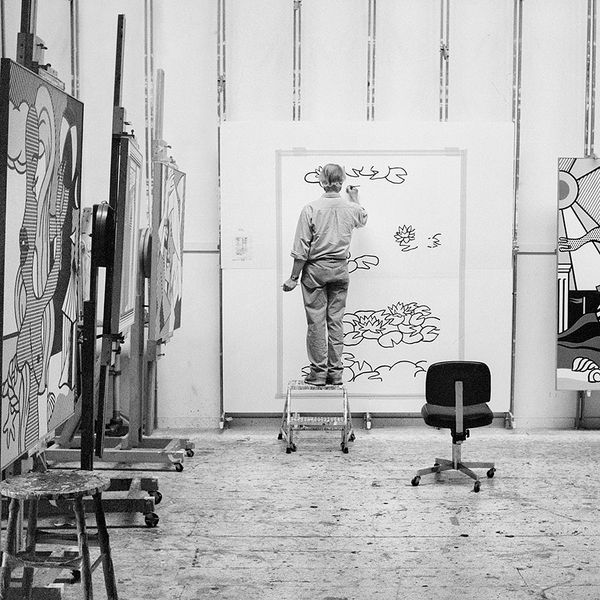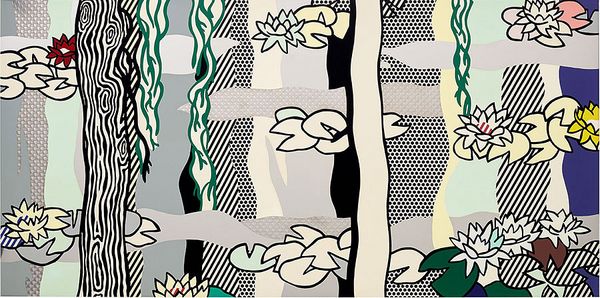Roy Lichtenstein, Water Lilies with Willows, from Water Lilies, 1992. Evening & Day Editions, London.
A pioneer of Pop Art in the United States, Roy Lichtenstein’s graphic art helped to define an aesthetic for the burgeoning movement in the 1960s. Famed for his comic-book motifs and his use of Ben-Day dots, Lichtenstein’s works are recognized for their mechanical appearance. Pop Art often celebrated a mass-produced and industrial aesthetic, devoid of brushstrokes and other explicit indications of the artist’s hand. At Pop Art’s inception, critics initially viewed the works of Lichtenstein and his contemporaries as highly controversial for their diversion from what was considered to be high art, marked by preceding artistic movements such as Impressionism. Regardless of such censure, Pop Art continued to flourish, with Lichtenstein becoming one of the most revered American artists of the 20th century. However, Lichtenstein satirically responded to early criticisms throughout his career; firstly, in his Brushstrokes series of 1965-66, where he elevated the gestural brushstroke to the main subject matter of his paintings, parodying their apparent importance to art critics through his heavily mechanized style. Secondly, he frequently revisited paintings from the art historical canon in order to break down the perceived distinction between high and low art and to demonstrate the possibilities that the Pop Art aesthetic afforded to him. These two approaches are exemplified in Lichtenstein’s View from the Window, 1985, and Water Lilies with Willows, 1992, both of which are included in Phillips’ upcoming Evening & Day Editions auction.

Left: Roy Lichtenstein, A View from the Window, from Landscapes, 1985. Evening & Day Editions, London. Right: Pierre Bonnard, Open Window in Uriage, 1918. Image: Luisa Ricciarini / Bridgeman Images.
In View from the Window, Lichtenstein takes a favored subject matter of the Post-Impressionists and Fauvists and transforms it using his unique visual vocabulary. Compositionally recalling works such as Henri Matisse’s Open Window, Collioure, 1905, or Pierre Bonnard’s Open Window in Uriage, 1918, Lichtenstein cleverly evokes the brushstrokes of his predecessors through the processes of screenprinting and lithography. This incredibly complex procedure involved the artist first painting the brushstrokes on vellum, using a mixture of powdered pigment and manga. The brushstrokes he created were then transferred on to photo-sensitized plates or screens to retain the fluidity and texture of the original stroke. Through this method, Lichtenstein was able to emulate the presence of the artist’s hand, contrasting this with the graphic woodcut lines that also feature in the image. In doing so, Lichtenstein demonstrates Pop Art’s ability to produce works of equal quality and skill to the venerated French modernists, all the while maintaining some of the graphic qualities that gave Pop Art such a contemporary edge.

Claude Monet, Waterlilies, 1916-19. Image: Bridgeman Images.
View from the Window is one of six prints that make up Lichtenstein’s Landscape Series. Other images from the series include The Sower – a work directly inspired by Van Gogh’s painting of the same title – and The River, which recalls Impressionist depictions of the Seine, such as Edouard Manet’s The Seine at Argenteuil, 1874, or Gustave Caillebotte’s Factories at Argenteuil, 1888. Outside of this series, Lichtenstein created his own iterations of Claude Monet’s Rouen Cathedral and Haystacks in 1968 and 1969 respectively, demonstrating a sustained interest in applying the Pop Art aesthetic to historic masterpieces. Referring to these works fondly as his “manufactured Monets,” Lichtenstein relished combining his graphic aesthetic with the revered French master’s compositions. In 1992, Lichtenstein turned to Monet’s most famous works: his paintings of water lilies at Giverny, France. In Water Lilies with Willows – one of six screenprints the artist produced in 1992 in reference to Monet’s paintings – Lichtenstein parodies these iconic works of art history, translating them for the modern age through his Pop Art aesthetic. In doing so, Lichtenstein revealed some unexpected parallels between the two artists’ formal concerns, despite their drastically different artistic styles.

Claude Monet in his workshop in front of one of his paintings Waterlilies, c. 1918. Image: Bridgeman Images.
A key priority in the works of Monet and the Impressionists was capturing the subtle changes in light conditions and that desire drove Monet to create over 250 oil paintings of the water lilies at Giverny. His fascination with light and its reflections produced some of the most spectacular renderings of water within the art historical canon. Acknowledging that the rendering of such delicate nuance in thick oils worked against his clinical and mechanical aesthetic style, Lichtenstein explored alternative ways to replicate the subtleties in Monet’s composition. Constructed using sign painter’s enamel screenprinted onto stainless steel, Lichtenstein’s Water Lilies series reinforces the industrial essence of his practice. However, his innovative use of stainless steel as the surface for his works gives them a reflective quality, mirroring the lighting, colors, and contents of the room in which they are exhibited. As stated by Mary Lee Corlett, Lichtenstein’s Water Lilies “transmogrify,” constantly changing as they are viewed from different angles. Lichtenstein’s choice of medium in Water Lilies with Willows allowed the artist to accurately replicate the characteristics of water, as Monet had sought to do through oil paint almost a century earlier. Lichtenstein had long been interested in reflections, most evidently exemplified in his Mirror Series of 1972, and his mediations on Monet’s works allowed him to further experiment with incorporating reflection into his art. The result is a modernized depiction of Monet’s Impressionist masterpiece, paradoxical in its use of industrial materials to portray the effects of the natural world.

Roy Lichtenstein works on a water lilies piece at his Southampton studio, 1992. Image: © Laurie Lambrecht.
Lichtenstein’s parodies of his artistic predecessors’ techniques and subject matter highlight his admiration for these artists, while simultaneously showcasing the possibilities afforded to him through the Pop Art aesthetic. What might at first appear as whimsical Pop Art pastiches of revered paintings instead reveal complex explorations of medium, style and aesthetics. Lichtenstein created modern and eye-catching works, imbued with the formal concerns of his artistic predecessors. Both View from the Window and Water Lilies with Willows were conceived toward the end of Lichtenstein’s career — at a time when Pop Art was already an accepted and highly celebrated movement. Together, these works signify Lichtenstein’s unwavering promotion of his visual language and the skill required to produce such works.
Recommended Reading
